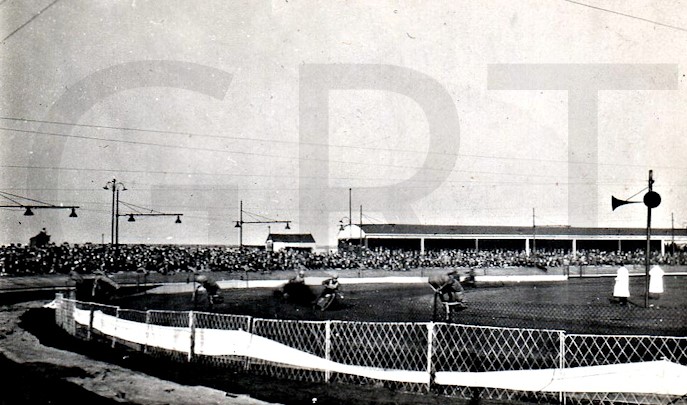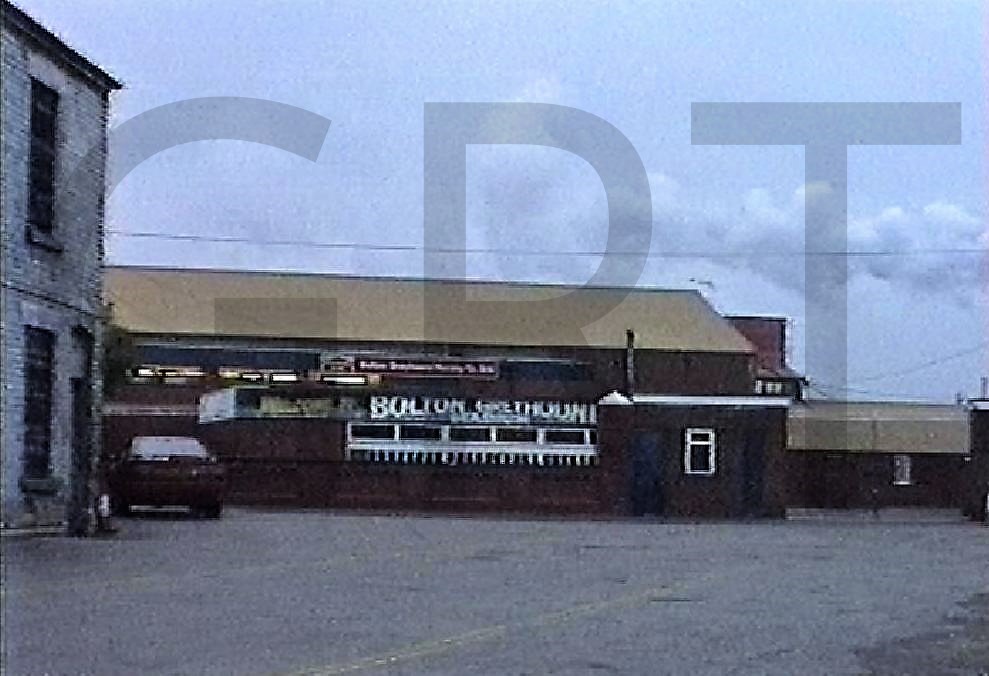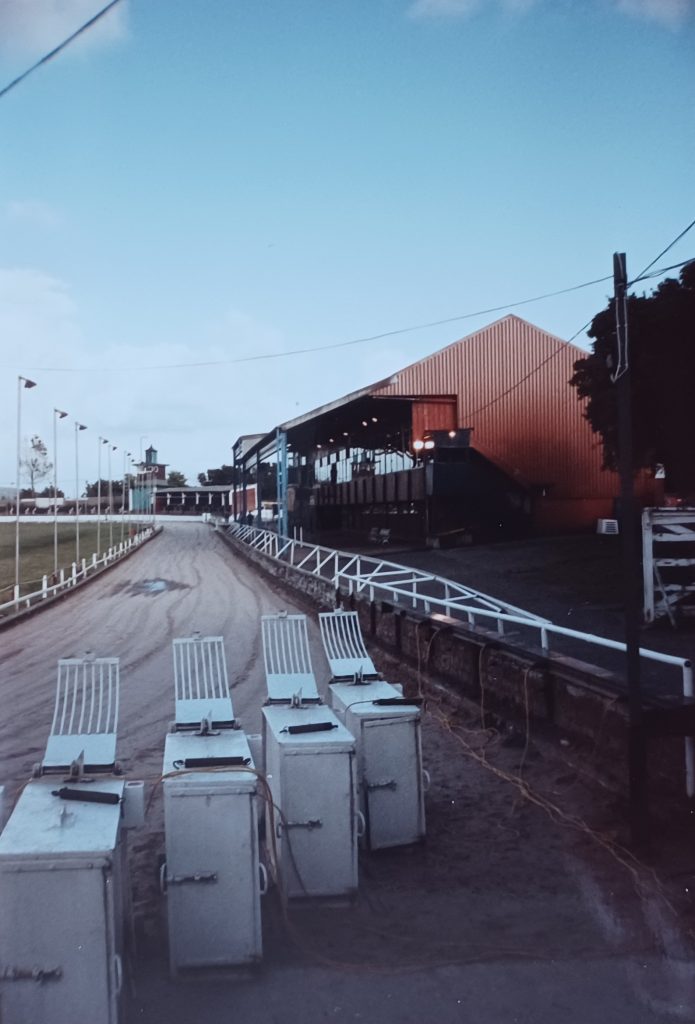Raikes Park Stadium, Manchester Road, Bolton, Lancashire.
POSTCODE————————————BL3 2NB
LOCATED—————————————One mile south of Bolton town centre, located between Manchester Road and the A666 bypass.
ORIGINAL SITE——————————–Disused Colliery site.
-DATE CONSTRUCTED———————1927
DATE VENUE OPENED———————December 1927.
Meaning other sports may have taken place prior to the arrival of Greyhound Racing.
FIRST MEETING——————————10th December 1927.
Greyhound Racing only.
LICENSED OR INDEPENDENT————Independent until switching to permit racing in 1995.
All venues covered would have to be licensed with the government, licensed suggested in this section would refer to tracks operating under NGRC Rules.
INSIDE OR OUTSIDE HARE TYPE——-Sumner Inside.
Please note that the Electric Hare suggested is only a guidance and would have been in operation for a certain amount of time at this venue. Although it is not necessarily guaranteed that it was operational all the time, as other types of lure may have been used and updated as time progressed.
DISTANCES————————————313, 535, 745 yards and 980 yards.
Please note that most racing venues distances had become varied throughout the years, the ones given above were at once point set and offers only a guidance to the track size.
CIRCUMFERENCE—————————432 yards.
Please note that alterations at most racing venues throughout its existence would see that the circumference of the track would vary, the one shown above offers only a guidance to the track size.
BIG RACE NAMES—————————Bolton Independent Greyhound Derby and Bolton St Leger.
STADIUM SHARED WITH—————–Speedway for a short period began 20th August 1928 and Stock Car Racing from 1992 until 1996.
It is common knowledge that a good number of the racecourses shared their facilities with other sports, but Raikes Park was a purpose built Greyhound Racing venue.
LAST MEETING——————————-Officially Wednesday 18th December 1996, yet two races were run on the following Saturday but was abandoned due to a frozen track.
Greyhound Racing only.
STADIUM CLOSURE DATE—————-December 1996.
Meaning other sports may have taken place after Greyhound Racing had ceased.
STADIUM DEMOLITION——————-Fixture removed in 1997 with Stadium demolished in 1999.
BUILT ON SITE——————————–Williams BMW Garage in 2007.
In some cases, structure’s that originally covered the venue after the stadium had been demolished, may have been themselves demolished too, so the one described is more likely to be the one which now presently covers the site.
EVIDENCE LEFT TODAY——————-Nothing known of.
FURTHER COMMENTS——————–In my view the most popular independent track in the UK.

Two images of a race card from Bolton’s first meeting. Race card shown not an original as copies were issued around the late 1980’s.
































Raikes Park Greyhound Stadium was located about one mile south of Bolton’s town centre, adjacent to the A666, heading out of town towards the boundaries of Farnworth. It had been constructed on the site of an old disused colliery, virtually within a stones throw away from Burnden Park, the then home to Bolton Wanderers Football Club.
The newly formed Bolton Greyhound Racing Company had been inspired by the success story of the nearby Belle Vue track in Manchester, which had opened eighteen months previous, and with Bolton being the third largest town in England, the chances of attracting the public’s attention were good. The company began by racing under their own independent rules, as the NGRC had not been formed by then, with some of the races acting as challenge events, with only two greyhounds taking part.
Bolton’s first meeting came on the evening of the 10th of December 1927, with a seven-race card on offer, with two of the races being run over hurdles. The first race was won by a greyhound called Conally Lass, who must have cheered her owner up immensely by picking up the impressive prize money of ten pounds. Although greyhound racing continued as its main attraction, an approach by dirt track speedway enthusiasts to construct a track within the infield of the dog track witnessed the sport to feature during 1928 and 29.
Greyhound racing at Bolton had proved itself an instant success, it had been enough to persuade the company’s directors to open a sister track thirteen miles away at Blackburn six years later. Bolton arguably became one of the best independent run tracks in Britain, it had a two-tiered stand covering the virtual full length of the start and finish straight, and opposite lay another single tiered smaller stand known as the cheap side, this too covered the whole length of the back straight. In later years both stands became glass fronted, with another shelter constructed over some terracing at the first bend.
Crowds flocked during its early years, the punters creating a unique atmosphere, as did the whistling and arm swinging tick tacks who communicated with the well-attended bookmakers on the opposite sides of the track. During the Second World War restrictions on track owned dogs being raced there were lifted, this was due to the shortage of animal feed available and gave the opportunity for privately owned dogs to race there.
During the seventies, the Bolton management would promote two or three special meetings per year, normally with a ten-race meeting, which would include two open race events made up of some of the best dogs from around the region. It was nights like these that you would see patrons pack the place to the rafters, with the “CAR PARK FULL” sign normally found at its entrance.
By the early 1980’s the running surface had changed to an all-sanded circuit, a period on which had seen a good number of tracks around the country do the same. Alarmingly the 1980’s also brought with it a concern regarding falling attendances, with the Bolton management team looking into ways of turning Raikes Park into a multi-purpose sporting venue. Bolton Wanderers Football Club began using the infield of the track as a training pitch, but a more ambitious and profitable move witnessed the beginning of Stock Car Racing, but that did not happen until the spring of 1992.
Raikes Park ran five dog races over distances of 313, 535 and 745 yards with the hounds chasing an inside Sumner type hare, before eventually switching to an outside Swaffham type during its latter days. By the 1990’s bigger prize money was on offer, the Bolton Independent Greyhound Derby would see the winner pick up a staggering £5000, with heats and final run over the 535-yard trip.
1994 had seen another change at Bolton, this time switching from an independently run track to racing under NGRC rules, with trainers having to apply for a permit license. But the permit system lasted for no longer than two years, not for the fact that it had failed, but the truth was that the stadium had been sold to developers for a substantial amount of money. A Saturday evening meeting on the 21st of December 1996 brought with it controversy, as after two races it was announced that the meeting would be abandoned, as certain sections of the track had become frozen. The decision had been made by the racing manager on the advice from the resident track vet, who had treated two greyhounds that had finished lame in the second race. Patrons were requested to retrieve their entrance fee back at the turnstiles or pick up some type of proof of entry to be used for the following Saturday meeting. But what happened the following Monday outraged its regulars, as the local newspaper had announced that the previous Saturday meeting had been its last. This angered racegoers, who had been under the impression that there would be at least one more meeting, and also had been promised their entrance fee back from the abandoned Saturday meeting.
Little else came from this but during the early months of 1997 the demise of the stadium was becoming more evident as parts of its interior and exterior began to be removed, before eventually being totally demolished in 1999. The site remained neglected right up until 2007, but things began to change when construction work began of a brand-new BMW showroom, which soon smothered all evidence of a greyhound track of ever having been there.

Recent Comments